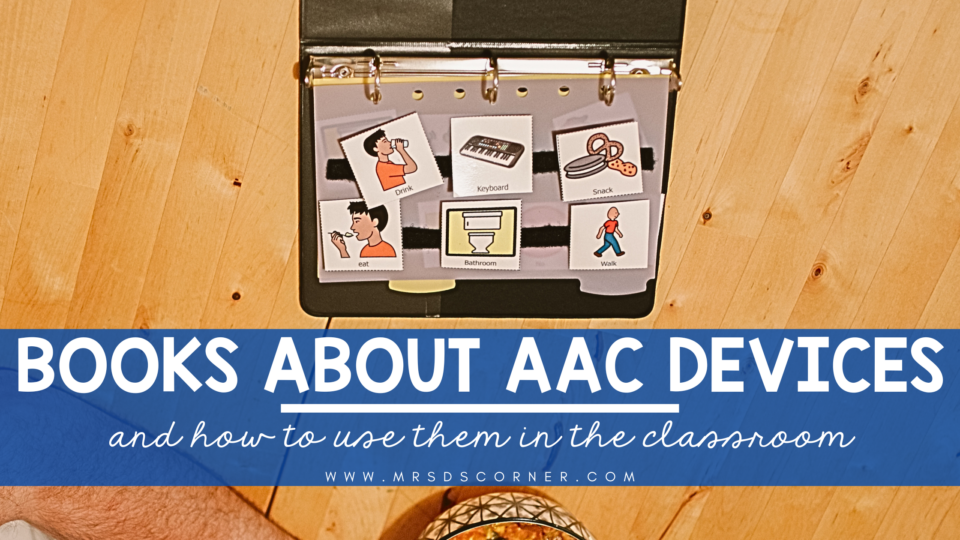Do you have students in your classroom or school who use AAC devices? Today, we are delving into the world of Augmentative and Alternative Communication (AAC) devices, focusing on how picture books can serve as a valuable tool in educating children about these communication aids.


Get ready to expand your students’ understanding of AAC devices!
What are AAC Devices?
AAC devices are tools used to support individuals with communication difficulties. These devices come in various forms, ranging from simple picture boards to sophisticated electronic systems. AAC devices enable users to express themselves and effectively convey their needs, thoughts, and emotions.
Why are Picture Books a Great Way to Teach Kids About AAC Devices?
Picture books offer a visual and engaging medium to introduce children to AAC devices. They help demystify these tools and normalize their use. By incorporating characters using AAC devices in stories, children can develop empathy, understanding, and acceptance towards individuals who rely on such devices for communication.
Moreover, picture books provide a concrete representation of how AAC devices work, making complex concepts more accessible to young minds. Through colorful illustrations and relatable narratives, children can grasp the significance of communication and the role AAC devices play in facilitating it.
Activities to Do with Picture Books About AAC Devices
Create Your Own AAC Device
Encourage children to design their own simple AAC boards using pictures or symbols. This hands-on activity can help them understand the basic principles of AAC communication.
Role-Playing
Act out scenarios from the picture books where characters use AAC devices to communicate. This interactive activity can enhance children’s comprehension and empathy towards individuals who use AAC devices in real life.
Discuss and Reflect
After reading a picture book about AAC devices, have a meaningful discussion with children about the importance of communication and the diverse ways people express themselves. Encourage them to reflect on how they can support friends or family members who use AAC devices.
Bring AAC Devices in the Classroom
Take learning hands-on after reading about AAC devices and bring some to your classroom. Let students explore them and get a better understanding of why and how they work.
This article contains affiliate links to products that might help you teach.
Picture Books About AAC Devices
In order to start the conversation about AAC devices with your students, try reading some of the picture books below!
Why My AAC Device Changed My Life!: A Children’s Book About Augmentative & Alternative Communication
by Crystal Holscher
Crystal Holscher, a speech-language pathologist, authored this picture book narrating Caroline’s journey of receiving the gift of communication through a specialized AAC device.
Roary’s Talker
by Emily Holmes
In this book, Roary the Dinosaur communicates her wants, needs, thoughts, and feelings using a speech-generating device to ensure everyone has a voice in all spaces.
Beyond Words: An Illustrated Story for Non-Verbal Children
by Dina Mountney
This illustrated book aims to teach children about acceptance by telling the story of a young puppy adopted into a loving family who faces bullying due to her inability to bark, highlighting the importance of understanding and valuing differences in others. Although there is no AAC device specifically mentioned, it’s a great story about communication.
Me and My AAC
by Tabitha Cabrera
Ben shares his unique way of communicating through his AAC device as he takes you on an adventure to experience the magic he sees in trains.
Something to Say About My Communication Device
by Eden Molineux
Kate, who is friendly and enjoys laughter, also has a competitive side. She uses a communication device to express herself. The book is part of the Something to Say Collection that encourages self-advocacy and understanding of speech differences through characters with unique communication styles.
Picture books are invaluable resources for introducing children to the world of AAC devices. By incorporating these books into educational settings, both in special education and general education classrooms, we can promote inclusivity, understanding, and empathy toward individuals with communication challenges. Embrace the power of storytelling in your classroom to foster a more compassionate and inclusive society!

